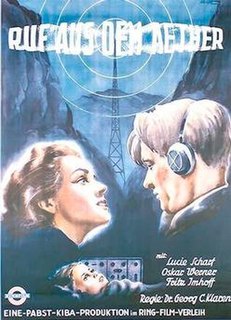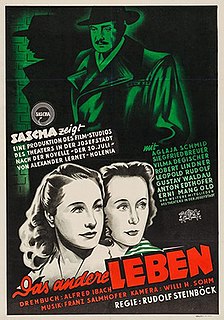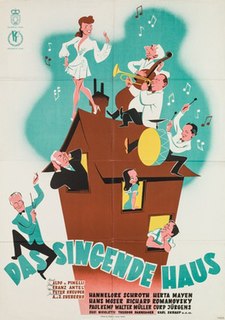Related Research Articles

Dunja is a 1955 Austrian historical drama film directed by Josef von Báky and starring Eva Bartok, Karlheinz Böhm, Ivan Desny and Walter Richter. It is an adaptation of the shorty story The Station Master by Alexander Pushkin, which had previously been made into the 1940 film Der Postmeister by Gustav Ucicky.
Sarajevo is a 1955 Austrian historical film directed by Fritz Kortner and starring Luise Ullrich, Ewald Balser and Franz Stoss. The film portrays the assassination of Archduke Franz Ferdinand of Austria in 1914. It proved controversial on its release.
Hans Olden (1892–1975) was an Austrian stage and film actor. Olden appeared in more than eighty films during his career, mostly in Austria but occasionally also in Germany. He was a supporter of the Austrian Nazi Party, his interest in Nazism pre-dating the Anchluss by some years. After the Second World War Olden appeared in a number of Heimat films.
Emil Burri (1902–1966) was a German playwright and screenwriter who worked on around fifty films during his career, a prominent figure in both Nazi era and post-war German cinema. He also directed the 1942 film Beloved World, his only directorial credit. In 1955 he wrote the screenplay for the Austrian historical heimatfilm Dunja.
Karl Löb (1910–1983) was an Austrian-born cinematographer. He worked on over ninety films in Austria and Germany including the 1953 comedy Miss Casanova. Löb was born to an ethnically German family in the Czech part of the Austro-Hungarian Empire, but emigrated to Berlin following the Empire's dissolution.
Adrienne Gessner was an Austrian actress. Gessner appeared in over fifty film and television shows during her career, including the 1955 costume film Hofjagd in Ischl. Gessner appeared in a mixture of German and Austrian films during her career. Following the Anchluss of 1938 she fled with her Jewish husband Ernst Lothar to the United States, returning after the Second World War.

Arena of Death is a 1953 Austrian-German crime film directed by Kurt Meisel and starring Richard Häussler, Katharina Mayberg, and Friedl Hardt.

Annaluise and Anton is a 1953 Austrian-West German comedy film directed by Thomas Engel and starring Paul Klinger, Hertha Feiler, and Heidemarie Hatheyer. It was one of the 10 most popular films released in Austria that year. It was made at the Sievering Studios in Vienna. The film's sets were designed by the art director Fritz Jüptner-Jonstorff. It was remade in 1999.
Sievering Studios were film production studios located in Sievering, a suburb of the Austrian capital Vienna.

Call Over the Air is a 1951 Austrian drama film directed by Georg C. Klaren and Georg Wilhelm Pabst and starring Oskar Werner, Lucia Scharf and Fritz Imhoff.

The King of Bernina is a 1957 Austrian-Swiss historical drama film directed by Alfred Lehner and starring Helmuth Schneider, Waltraut Haas and Walter Janssen.

Vienna Waltzes is a 1951 Austrian historical musical drama film directed by Emil E. Reinert and starring Marte Harell, Anton Walbrook and Lilly Stepanek. It is also known by the alternative title of Vienna Dances.

The Blue Star of the South is a 1951 Austrian comedy film directed by Wolfgang Liebeneiner and starring Viktor de Kowa, Gustav Knuth and Gretl Schörg.

Sweet Derriere is a 1975 Austrian sex comedy film directed by Georg Tressler and starring Werner Ploner, Gustav Schneller and Lydia Mikulski. The film's sets were designed by the art director Nino Borghi.
The Schönbrunn Studios were film studios located in the Austrian capital Vienna in the grounds of the Schönbrunn Palace. It took over the site of the old palm house which had been replaced by the newer Palmenhaus Schönbrunn in the 1880s.

The Other Life is a 1948 Austrian drama film directed by Rudolf Steinboeck and starring Aglaja Schmid, Robert Lindner and Gustav Waldau. The sets were designed by the art director Herbert Ploberger. It is based on the 1947 novella Twentieth of July by Alexander Lernet-Holenia.

The Singing House is a 1948 Austrian comedy film directed by Franz Antel and starring Richard Romanowsky, Hannelore Schroth and Hans Moser. It was first shown at the Locarno Film Festival in July 1947, before going on general release in Austria in early 1948.

My Father, the Ape and I is a 1971 Austrian-West German comedy film directed by Franz Antel and starring Gerhart Lippert, Mascha Gonska, Paul Löwinger.
Walking Back into the Past is a 1954 Austrian drama film directed by Karl Hartl and starring Paula Wessely, Attila Hörbiger and Josef Meinrad.

Gateway to Peace is a 1951 Austrian drama film directed by Wolfgang Liebeneiner and starring Paul Hartmann, Vilma Degischer and Hilde Krahl.
References
- ↑ Fritsche p.247